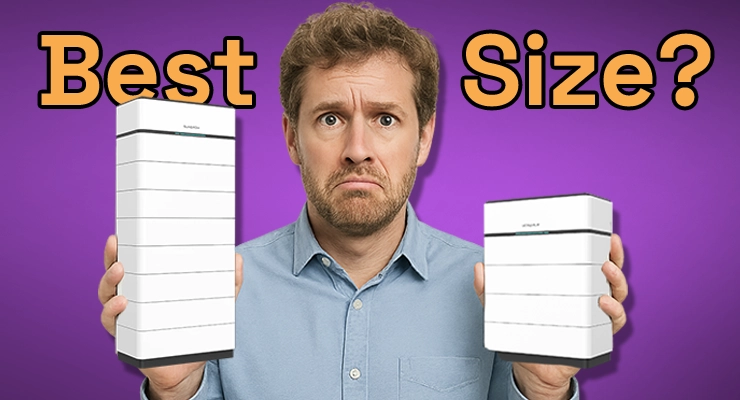Fast read
For a family of four with a large 13.2kW solar system, the ideal battery size typically ranges from 10kWh to 20kWh. The best choice depends on your daily energy consumption, which averages around 21.36 kWh for a four-person household in Australia, and your main goal—whether it's maximising solar usage to cut bills or ensuring backup power during outages. A battery with around 13.5kWh of usable capacity is often a sweet spot for balancing nightly energy needs and providing solid blackout protection.
What battery size is recommended for a 13.2kW solar system for a family of four?
A 13.2kW system is a significant residential power station, capable of generating a large amount of electricity, and pairing it with the correct battery ensures you harness that potential day and night.
For a family of four, this decision isn’t just about numbers; it’s about your lifestyle, your energy goals, and your desire for security. Let’s walk through the key considerations to find the perfect battery size for your household.
How much energy does your family and system produce?
Before picking a battery, it’s essential to understand your energy flows.
First, your solar system’s output. A 13.2kW solar system in Australia can generate a substantial amount of power, typically between 40kWh and 65kWh per day, depending on your location, weather, and the orientation of your panels. This is often more than enough to power a home during the day and charge a battery simultaneously.
Second, your family’s consumption. A typical four-person household in Australia uses around 21.36 kWh of electricity per day. However, consumption can fluctuate based on location and lifestyle. The critical detail is when you use this energy. Most families use a large portion of their power in the morning before school and work, and in the evening after the sun has gone down. This evening peak is precisely what a solar battery is designed to cover.
What is your main goal for getting a battery?
Your primary motivation for adding storage will be the biggest factor in determining the right size. Homeowners generally have one of two main objectives:
- Maximising Self-Consumption: Your goal is to use as much of your own solar power as possible to slash your electricity bills. You want to store excess daytime solar energy to power your home through the evening peak demand period when electricity from the grid is most expensive.
- Backup Power and Resilience: Your main concern is keeping the lights on and essential appliances running during a grid blackout. While you also want to save money, your priority is energy security for your family.
For most families, the ideal solution is a balance of both.
Sizing your battery for maximum savings
If your focus is on reducing your power bills, you need a battery large enough to cover your typical overnight energy usage. A good way to estimate this is to look at your electricity bill or use a home energy monitor to see how many kilowatt-hours (kWh) you use between sunset and sunrise.
For a family of four using 22kWh per day, a common scenario is using about 30% (6.6kWh) during the day and the remaining 70% (15.4kWh) at night and in the morning.
In this case, a battery with a usable capacity of around 10kWh to 15kWh would be an excellent choice. This allows you to significantly offset your evening grid usage. A popular option like the Tesla Powerwall 2, with 13.5kWh of usable capacity, fits perfectly within this range and can power a home through the evening and have some reserve.
Sizing your battery for blackout protection
If backup power is your priority, you’ll need to consider not just your evening usage but also which appliances you want to keep running during an outage. Essential loads typically include your refrigerator, lights, modem, and a few power points for charging devices. High-power appliances like air conditioners, ovens, and pool pumps will drain a battery very quickly.
A 10kWh to 15kWh battery can comfortably run your essential appliances for many hours, or even a full day, depending on your usage. If you want to back up more of your home or ride out longer outages, you might consider a larger battery or a system that is modular and can be expanded later.
For instance, the Sigenergy SigenStor is a modular system built from 5kWh and 8kWh battery modules. This allows you to start with a size that meets your immediate needs and budget—such as a single 8kWh module—and expand up to 48kWh in a single stack later if your family’s energy consumption grows.
The sweet spot: Finding the right balance for a 13.2kW system
For a family of four with a powerful 13.2kW solar system, a battery in the 10kWh to 20kWh range is generally the recommended starting point.
- 10kWh Battery: A 10kWh battery is a great entry point. It will cover a significant portion of your evening peak usage, leading to substantial bill savings, and provide several hours of backup for essential devices.
- 13-15kWh Battery: This size often represents the best balance of cost and benefit. It can store enough energy to get most families through the entire night on solar power and offers robust blackout protection. Systems like the Tesla Powerwall 2 (13.5kWh) are designed for this very purpose.
- 20kWh+ Battery: If you have very high overnight energy usage (e.g., charging an electric vehicle) or want multiple days of energy autonomy, a larger capacity is justified. Modular systems from brands like Sigenergy or Sungrow allow you to achieve this. Sungrow’s SBR series, for example, uses 3.2kWh modules to build battery towers with capacities ranging from 9.6kWh to 25.6kWh.
Important questions to ask your installer
Sizing your battery is a collaborative process with your chosen solar professional. To ensure you get the right outcome, be prepared to discuss these points:
- What is my detailed daily and interval energy usage? A good installer will analyse your smart meter data to understand your specific consumption patterns.
- What is the battery’s usable capacity and depth of discharge (DoD)? A battery’s total capacity and its usable capacity can be different. A higher DoD means you can use more of the stored energy.
- What is the battery’s power rating (kW)? This determines how many appliances can run simultaneously. A battery with a higher power rating can handle more demanding loads.
- Can the system be expanded in the future? If you think your needs might grow, choosing a modular system is a smart, future-proof decision.
By carefully considering your family’s unique energy habits and future goals, you and your installer can confidently select a battery that perfectly complements your 13.2kW solar system, delivering savings and security for years to come.





